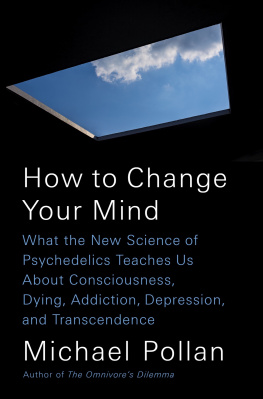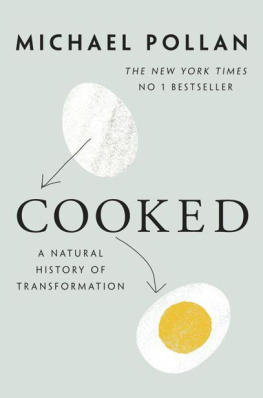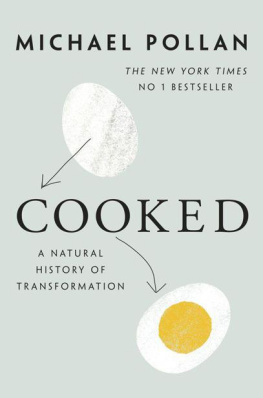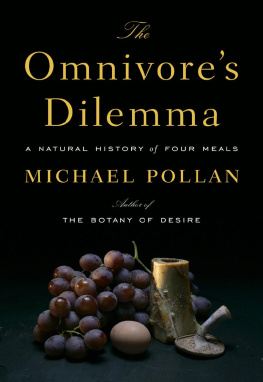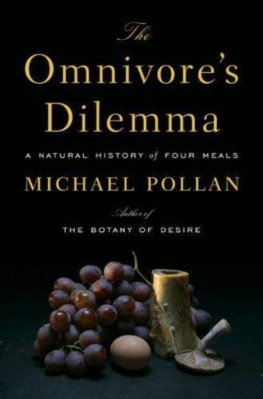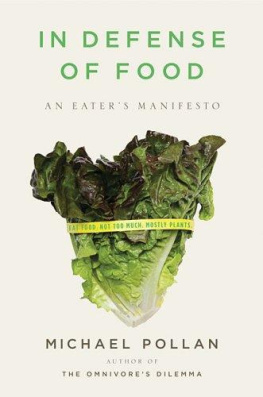INTRODUCTION OUR NATIONAL EATING DISORDER
What should we have for dinner? This book is a long and fairly involved answer to this seemingly simple question. Along the way, it also tries to figure out how such a simple question could ever have gotten so complicated. As a culture we seem to have arrived at a place where whatever native wisdom we may once have possessed about eating has been replaced by confusion and anxiety. Somehow this most elemental of activitiesfiguring out what to eathas come to require a remarkable amount of expert help. How did we ever get to a point where we need investigative journalists to tell us where our food comes from and nutritionists to determine the dinner menu? For me the absurdity of the situation became inescapable in the fall of 2002, when one of the most ancient and venerable staples of human life abruptly disappeared from the American dinner table. I'm talking of course about bread. Virtually overnight, Americans changed the way they eat. A collective spasm of what can only be described as carbophobia seized the country, supplanting an era of national lipophobia dating to the Carter administration.That was when, in 1977, a Senate committee had issued a set of "dietary goals" warning beef-loving Americans to lay off the red meat. And so we dutifully had done, until now. What set off the sea change? It appears to have been a perfect media storm of diet books, scientific studies, and one timely magazine article. The new diet books, many of them inspired by the formerly discredited Dr. Robert C. Atkins, brought Americans the welcome news that they could eat more meat and lose weight just so long as they laid off the bread and pasta. These high-protein, low-carb diets found support in a handful of new epidemiological studies suggesting that the nutritional orthodoxy that had held sway in America since the 1970s might be wrong. It was not, as official opinion claimed, fat that made us fat, but the carbohydrates we'd been eating precisely in order to stay slim. So conditions were ripe for a swing of the dietary pendulum when, in the summer of 2002, the New York Times Magazine published a cover story on the new research entitled "What if Fat Doesn't Make You Fat?" Within months, supermarket shelves were restocked and restaurant menus rewritten to reflect the new nutritional wisdom. The blamelessness of steak restored, two of the most wholesome and uncontroversial foods known to manbread and pastaacquired a moral stain that promptly bankrupted dozens of bakeries and noodle firms and ruined an untold number of perfectly good meals. So violent a change in a culture's eating habits is surely the sign of a national eating disorder. Certainly it would never have happened in a culture in possession of deeply rooted traditions surrounding food and eating. But then, such a culture would not feel the need for its most august legislative body to ever deliberate the nation's "dietary goals"or, for that matter, to wage political battle every few years over the precise design of an official government graphic called the "food pyramid." A country with a stable culture of food would not shell out millions for the quackery (or common sense) of a new diet book every January. It would not be susceptible to the pendulum swings of food scares or fads, to the apotheosis every few years of one newly discovered nutrient and the demonization of another. It would not be apt to confuse protein bars and food supplements with meals or breakfast cereals with medicines. It probably would not eat a fifth of its meals in cars or feed fully a third of its children at a fast-food outlet every day. And it surely would not be nearly so fat. Nor would such a culture be shocked to discover that there are other countries, such as Italy and France, that decide their dinner questions on the basis of such quaint and unscientific criteria as pleasure and tradition, eat all manner of "unhealthy" foods, and, lo and behold, wind up actually healthier and happier in their eating than we are. We show our surprise at this by speaking of something called the "French paradox," for how could a people who eat such demonstrably toxic substances as foie gras and triple creme cheese actually be slimmer and healthier than we are? Yet I wonder if it doesn't make more sense to speak in terms of an American paradoxthat is, a notably unhealthy people obsessed by the idea of eating healthily.
To one degree or another, the question of what to have for dinner assails every omnivore, and always has. When you can eat just about anything nature has to offer, deciding what you should eat will inevitably stir anxiety, especially when some of the potential foods on offer are liable to sicken or kill you. This is the omnivore's dilemma, noted long ago by writers like Rousseau and Brillat-Savarin and first given that name thirty years ago by a University of Pennsylvania research psychologist named Paul Rozin. I've borrowed his phrase for the tide of this book because the omnivore's dilemma turns out to be a particularly sharp tool for understanding our present predicaments surrounding food. In a 1976 paper called "The Selection of Foods by Rats, Humans, and Other Animals" Rozin contrasted the omnivore's existential situation with that of the specialized eater, for whom the dinner question could not be simpler. The koala doesn't worry about what to eat: If it looks and smells and tastes like a eucalyptus leaf, it must be dinner. The koala's culinary preferences are hardwired in its genes. But for omnivores like us (and the rat) a vast amount of brain space and time must be devoted to figuring out which of all the many potential dishes nature lays on are safe to eat. We rely on our prodigious powers of recognition and memory to guide us away from poisons (Isn't that the mushroom that made me sick last week?) and toward nutritious plants (The red berries are the juicier, sweeter ones). Our taste buds help too, predisposing us toward sweetness, which signals carbohydrate energy in nature, and away from bitterness, which is how many of the toxic alkaloids produced by plants taste. Our inborn sense of disgust keeps us from ingesting things that might infect us, such as rotten meat. Many anthropologists believe that the reason we evolved such big and intricate brains was precisely to help us deal with the omnivore's dilemma. Being a generalist is of course a great boon as well as a challenge; it is what allows humans to successfully inhabit virtually every terrestrial environment on the planet. Omnivory offers the pleasures of variety, too. But the surfeit of choice brings with it a lot of stress and leads to a kind of Manichaean view of food, a division of nature into The Good Things to Eat, and The Bad. The rat must make this all-important distinction more or less on its own, each individual figuring out for itselfand then remembering which things will nourish and which will poison. The human omni-vore has, in addition to his senses and memory, the incalculable advantage of a culture, which stores the experience and accumulated wisdom of countless human tasters before him. I don't need to experiment with the mushroom now called, rather helpfully, the "death cap," and it is common knowledge that that first intrepid lobster eater was on to something very good. Our culture codifies the rules of wise eating in an elaborate structure of taboos, rituals, recipes, manners, and culinary traditions that keep us from having to reenact the omnivore's dilemma at every meal. One way to think about America's national eating disorder is as the return, with an almost atavistic vengeance, of the omnivore's dilemma. The cornucopia of the American supermarket has thrown us back on a bewildering food landscape where we once again have to worry that some of those tasty-looking morsels might kill us. (Perhaps not as quickly as a poisonous mushroom, but just as surely.) Certainly the extraordinary abundance of food in America complicates the whole problem of choice. At the same time, many of the tools with which people historically managed the omnivore's dilemma have lost their sharpness hereor simply failed. As a relatively new nation drawn from many different immigrant populations, each with its own culture of food, Americans have never had a single, strong, stable culinary tradition to guide us. The lack of a steadying culture of food leaves us especially vulnerable to the blandishments of the food scientist and the marketer, for whom the omnivore's dilemma is not so much a dilemma as an opportunity. It is very much in the interest of the food industry to exacerbate our anxieties about what to eat, the better to then assuage them with new products. Our bewilderment in the supermarket is no accident; the return of the omnivore's dilemma has deep roots in the modern food industry, roots that, I found, reach all the way back to fields of corn growing in places like Iowa. And so we find ourselves where we do, confronting in the supermarket or at the dinner table the dilemmas of omnivorousness, some of them ancient and others never before imagined. The organic apple or the conventional? And if the organic, the local one or the imported? The wild fish or the farmed?The trans fats or the butter or the "not butter"? Shall I be a carnivore or a vegetarian? And if a vegetarian, a lacto-vegetarian or a vegan? Like the hunter-gatherer picking a novel mushroom off the forest floor and consulting his sense memory to determine its edibility, we pick up the package in the supermarket and, no longer so confident of our senses, scrutinize the label, scratching our heads over the meaning of phrases like "heart healthy," "no trans fats," "cage-free," or "range-fed." What is "natural grill flavor" or TBHQ or xanthan gum? What is all this stuff, anyway, and where in the world did it come from?


